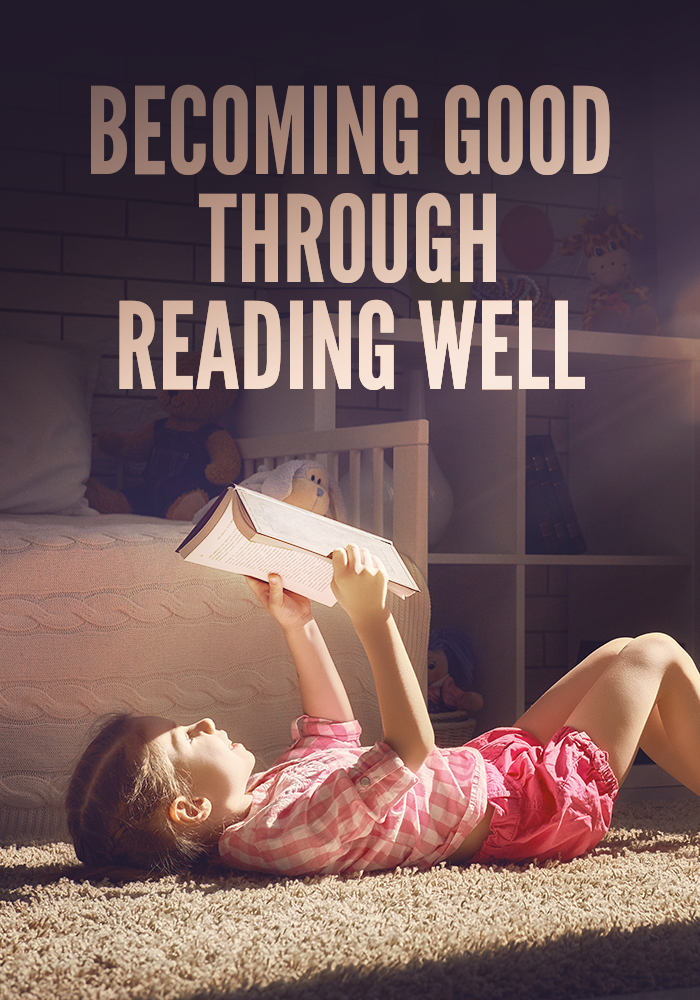Becoming Good Through Reading Well

Karen Swallow Prior has been teaching literature at the collegiate level for nearly three decades. During that time, she says she’s noticed that
Many readers have been conditioned to jump so quickly to interpretation and evaluation that they often skip the fundamental but essential task of comprehending what the words actually mean.
She notes that this failure to attend properly to the text is even reflected in bodily posture: “Often their first response is to turn their eyes upward in search of a thought or an idea, rather than to look down at the words on the page in front of them where the answer actually lies.” Fortunately, while “attending to the words on the page requires deliberation,” the ability to do so “improves with practice.” Prior’s new book On Reading Well: Finding the Good Life Through Great Books seeks to convince you that “It is not enough to read widely. One must also read well.” And to make her case, Prior weaves together philosophy (particularly Aristotelian virtue-ethics) and close-readings of great books, including well-known works like Jane Austen’s Persuasion and lesser-known masterpieces like Shusaku Endo’s Silence. But Prior does not just seek for us to be good readers, she also wants us to become good people and she believes that good literature is essential in achieving that goal.
Virtue and Storytelling
Discussing virtue in connection to stories might call to mind the kind of overly didactic fables told to kids in an attempt to teach them some “moral” or lesson. This is not at all what Prior has in mind. First, Prior thinks that the very activity of reading is connected with the cultivation and expression of virtue.
There is something in the very form of reading – the shape of the action itself – that tends toward virtue. The attentiveness necessary for deep reading…requires patience. The skills of interpretation and evaluation require prudence. Even the simple decision to set aside time to read in a world rife with so many other choices competing for our attention requires a kind of temperance.
Second, when Prior describes a book as virtuous, she means that it functions as a “vision of the good life,” which means the goodness is found in the world of the book, inseparable therefore from the characters, the plot, maybe even the very literary form of the book, and thus not found in some lesson that can be extracted out of the book. And so her argument is less that reading good books can teach good lessons and more that reading good books can cultivate “knowledge of and desire for the good.”
Literary Criticism and Finding Meaning
The value of literary criticism is that it can help us put into words the various intuitions we often have about the deep meanings of a story. Prior spends the bulk of the book sharing reflections on some of her favorite literary works, helping to tease out the various ideas and insights she sees embedded in those stories. One particularly notable chapter is her discussion of Mark Twain’s beloved and enduring novel Huckleberry Finn. For Prior, Twain’s novel is a rich exploration of the importance of courage in our lives. She writes that “Huck finds his courage, albeit accidentally, through circumstances that come partly from his own doing and partly from sheer bad luck.” The beauty of this story is that it “reflects the way life falls out for most of us most of the time: some choices we face are the result of our own doings, others completely outside of our control, most some combination of the two.”
Twain’s novel also gives us characters who subtly show us what counterfeit courage looks like. For example, The King and the Duke “display ample boldness” but “gall is not the same as courage. Men who swindle, cheat, and steal their way through life, no matter how brazenly, are far from virtuous, and therefore do not have virtuous courage.” Similarly, as loveable a character as Tom Sawyer is, he isn’t an exemplar of this virtue either.
If facing difficulty were the only thing required of courage, then all a would-be hero would have to do is create obstacles to overcome, and voila! – courage would be born. This is exactly what the lovable but foolish Tom Sawyer does.
Courage requires prudential judgment: it doesn’t embrace risk for the sake of having an adventure. But that isn’t to say that courage avoids risk altogether. Prior draws attention to the willingness shown by Jim to risk becoming enslaved again in order to rescue Tom. She writes: “recognizing the risk and facing it for a greater good – a boy’s life rather than his own freedom – Jim embodies the virtue of courage,” and further, that “Jim’s courage is rooted in both reason and conscience.” Thinking through the moral complexity in the novel can be a helpful aid but the key is reading the novel itself, which is ultimately what Prior is hoping her chapter will entice you to do. After all, you can drill a student on the dictionary differences between courage versus bravado, but if you want to inspire that student to want to be or become courageous, nothing beats reading the novel aloud, and allowing her to judge for herself which characters she wants to emulate.
In the end, Prior’s book does two things for the reader. First, it reminds the reader that literature really does matter in cultivating our interior life. She writes that “reading well adds to our life – not in the way as a tool from the hardware store adds to our life, for a tool does us no good once lost or broken, but in the way a friendship adds to our life, altering us forever.” The second thing that Prior does for her readers is, of course, to introduce them to twelve great books that we can read and love as friends who add to our life.
